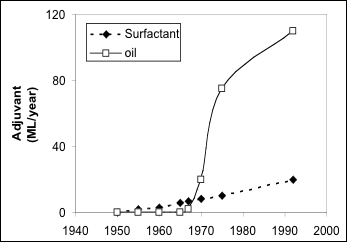|
|
FAQ regarding adjuvants
Note: The questions 4, 5, 6, 7 and 9 and their answers are influenced by Allen Underwood's publication in the ISAA 2001 Proceedings, pp. 251-260.
1. Since when are adjuvants used for agrochemicals and what type of products are used? From 1880 until 1960, the following products were used as adjuvants for insecticides and fungicides (McWhorter 1982):
All these products were used on an empirical basis. Although different per product, these products enhanced adhesion of the spray solution to the leaf surface, improved solubilization of the active ingredient and kept the drop deposit moist by retention of water. Until 1960, herbicides were occasionally mixed with caseinate glue, diesel oil and household detergent. In the sixties of the previous century, synthetic emulsifiers and surfactants were introduced together with the synthetic herbicides and other synthetic pesticides. The first large scale applications (McWhorter 1982) were conducted with atrazin (maize) and diuron (cotton).
2. What is the current use of tank-mix adjuvants? Producers of pesticides may incorporate an adjuvant into the formulation ('built-in adjuvant'). Adjuvant producers can recommend, sometimes in collaboration with the producer of the active ingredient, to add an adjuvant to the treatment solution ('tank-mix adjuvant'). In the USA (Uttley 1995) the use of emulsifiable oils (110ML/year) exceeds that of surfactant as tank-mix adjuvant (20ML/year) (Figure 1). In Europe (Uttley 1995), the volumes of emulsifiable oils (9ML) equals the use of surfactants (11ML). The graph in figure 1 stops at the mid nineties. As far as we know, use of adjuvants continued to increase since then. Nowadays, the worldwide (tank-mix) adjuvant market is estimated as a one billion USD market with the USA having a relatively larger share of 40% (Underwood et al 2001).
Figure 1. Annual use of tank mix-adjuvants in the USA. Figure based on two sources (McWhorter 1982 and Uttley 1995).
The percentage of adjuvant in the treatment solution determines retention of spray solution by the foliage in case of surface-active adjuvants, determines the influence on the foliar uptake of agrochemicals and determines phytotoxicity of the adjuvants themselves. When using L/ha, the concentration will vary with the application volume (mostly water). We recommend the use of percentage for the application of adjuvants.
4. Why are adjuvants not always included in the formulations produced by the basic manufacturers?
5. Is glyphosate the best adjuvant for glyphosate? No! Adjuvants can have specific functions in relation to glyphosate like overcoming the deleterious effects of low relative humidity or rainfall soon after treatment. Further, adjuvants can improve both wetting of the weeds and the foliar uptake of glyphosate. Glyphosate is less effective than adjuvants in prosecuting these functions.
6. Can modifying spray application equipment replace the need for adding adjuvant? Spray application technology is very relevant for optimizing deposition pattern on the crops and weeds. Drift reduction can be achieved by selection of appropriate nozzles. Adjuvants or formulations can have a specific substantial influence on drift, spray retention and uptake into the target. We do not consider improved application technology as a substitute for an adjuvant.
7. Can ammonium sulphate replace a surfactant or oil? The mode of action of salts differs from that of oils and surfactants. Although a similar effect can be observed in some applications, the suggested replacement cannot be considered as a general guideline.
8. Are there universal adjuvants that work in all applications? Adjuvant publications over the last 40-50 years learned that the adjuvant performance depends on many variables: active ingredient, formulation, and properties of the targets (crops/weeds/insects etc.). As a consequence optimization of adjuvant use should be achieved per active ingredient and per type of application.
9. Are there guidelines for the concentrations of adjuvants in the treatment solution?
Concentration in % (v/v) or % (w/v) depending on the product.
|

